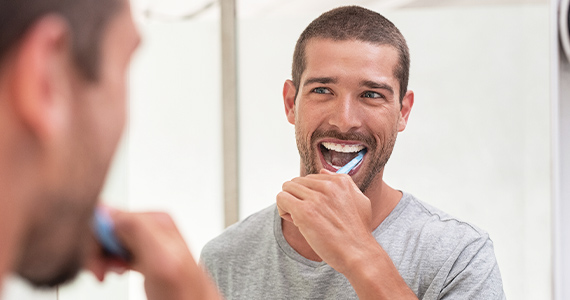Tips for Proper Brushing and Flossing
Proper brushing and flossing are essential for good oral health.

Brushing Time
Brushing your teeth is one of the most effective ways to remove bacteria (plaque) from your teeth. This helps to prevent tooth decay and gum disease.
Each tooth has five surfaces (top or chewing surface and four sides) that need to be cleaned. Toothbrushing cleans three of the five surfaces.
Many people overestimate the amount of time they brush their teeth. At least two minutes is recommended, but in reality some people brush for 30 seconds or less. If you have an electric toothbrush with a built-in timer, be sure to use it.
Ideally, tooth brushing should be done after every meal, but it is most important before bedtime.
Brushing Technique
Place a soft-bristle brush at a 45-degree angle to the tooth and use a gentle massaging action in small circular strokes.
Brush the outer and inner surfaces of the tooth, including close to the gum line.
Use the front tip or "toe" of the brush for the inner front tooth surfaces.
Apply light pressure as you brush. Teeth are covered by a fairly thin layer of enamel that can be worn down by vigorous scrubbing.
Always use fluoride toothpaste. It is one of the most effective ways to deliver decay-preventing fluoride to your teeth.
Flossing Technique
Brushing alone isn't enough to remove plaque from tooth surfaces. Flossing cleans the areas between the teeth, where the toothbrush can't reach. If the plaque is not removed from these areas, your risk for tooth decay and gum disease increases.
How to Floss
- Use about 18 inches of floss, winding most of it around your index finger on one hand and the rest around the index finger of your other hand. This finger guides the floss.
- Gently guide about an inch of floss between your teeth using your thumbs and index fingers. Be careful because the gums can be injured if floss is "snapped" into place.
- Once the floss is between the teeth, curve the floss into a C-shape against the side of each tooth and move it up and down.
- Repeat for all teeth and the back of the last teeth in each arch.
Additional Flossing Tips
Your gum tissue may be sore and bleed if you do not floss daily. Bleeding should stop once you begin flossing and all the bacteria are routinely removed.
Supervise your children's flossing until they can demonstrate the manual hand dexterity to do it on their own. Many children cannot floss properly until about the age of 10.
Save With Blue365®
BCBS FEP Dental members can access premier health and wellness discounts from leading brands through our Blue365 program. Many deals are available and new ones are constantly being added. To help you maintain a healthy smile, you can get discounts on oral care products along with other personal care items. Visit Blue365 to learn more.
Note: The information in this article is not meant to replace the advice of your dentist or another licensed healthcare professional. Talk to your dentist for any specific dental advice.
Sources: American Dental Association: https://www.mouthhealthy.org/all-topics-a-z/brushing-your-teeth https://www.mouthhealthy.org/all-topics-a-z/flossing






